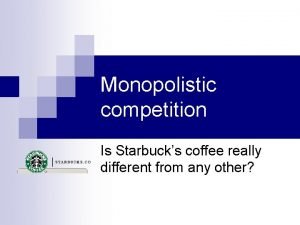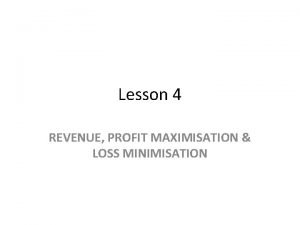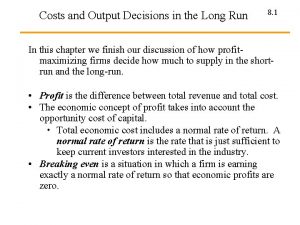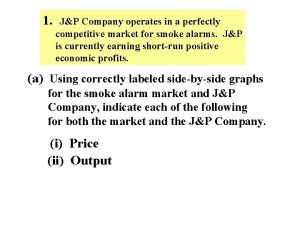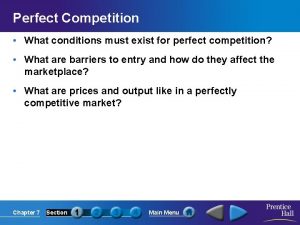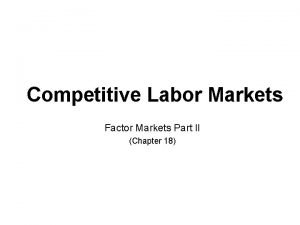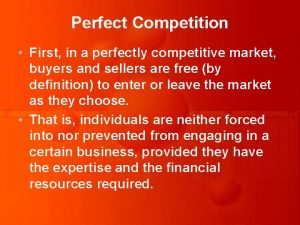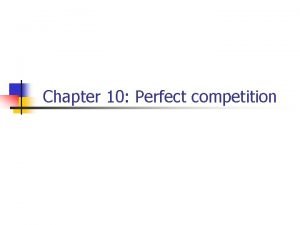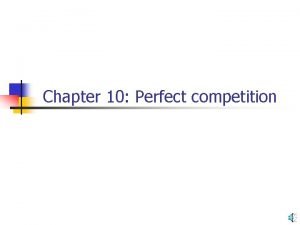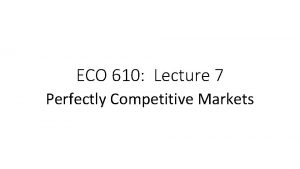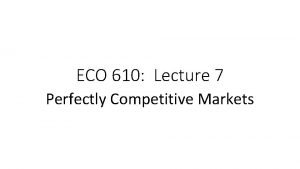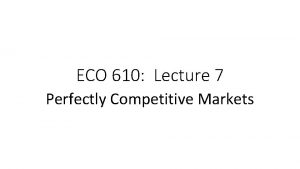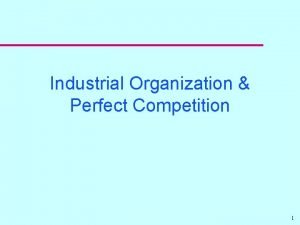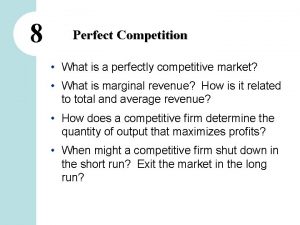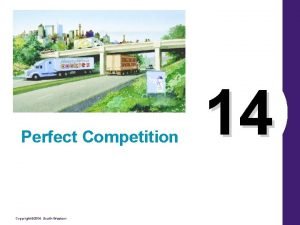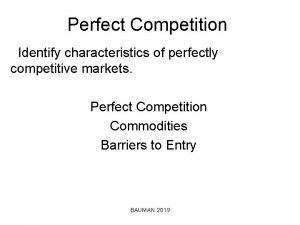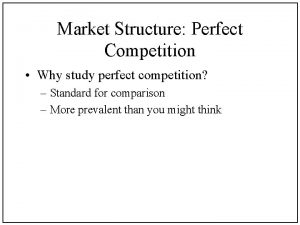Perfect Competition First in a perfectly competitive market



















- Slides: 19

Perfect Competition • First, in a perfectly competitive market, buyers and sellers are free (by definition) to enter or leave the market as they choose. • That is, individuals are neither forced into nor prevented from engaging in a certain business, provided they have the expertise and the financial resources required.

• Second, in the perfectly competitive free market, all exchanges are fully voluntary. • That is, participants are not forced to buy or sell anything other than what they freely and knowingly consent to buy or sell. • Third, no single seller or buyer will so dominate the market that he is able to force the others to accept his terms or go without.

Perfect Competition • In this market, industrial power is decentralized among numerous firms so that prices and quantities are not dependent on the whim of one or a few businesses. • In short, perfectly competitive free markets embody the negative right of freedom from coercion. Thus, they are perfectly moral in three important respects:

a) Each continuously establishes a capitalist form of justice. b) Together they maximize utility in the form of market efficiency. c) Each respects certain important negative rights of buyers and sellers. No single seller or buyer can dominate the market and force others to accept his terms. Thus, freedom of opportunity, consent, and freedom from coercion are all preserved under this system.

Moral features of perfectly competitive free markets. 1. First, perfectly competitive free markets do not establish other forms of justice. For example, they cannot establish a justice based on needs. 2. Competitive markets maximize the utility of those who can participate in the market given the constraints of each participant's budget.

Moral features of perfectly competitive free markets 3. Although free competitive markets establish certain negative rights for those within the market, they may actually diminish the positive rights of those whose participation is minimal. 4. Free competitive markets ignore and even conflict with the demands of caring.

Moral features of perfectly competitive free markets 5. Free competitive markets may have a pernicious effect on people's moral character. The competitive pressures that are present in perfectly competitive markets can lead people to attend constantly to economic efficiency.

Perfect Competition 6. Finally, and most important, we should note that the three values of capitalist justice, utility, and negative rights are produced by free markets only if they embody the seven conditions that define perfect competition.

Perfect Competition • If one or more of these conditions are not present in a given real market, then the claim can no longer be made that these three values are present. This, in fact, is the most important limitation of free market morality, because free markets are not perfectly competitive, they do not achieve the moral values.

Monopoly Competition • In a monopoly, two of the seven conditions are absent: there is only one seller, and other sellers cannot enter the market, such markets are far from the perfectly competitive model.

Monopoly Competition • Although Alcoa's patents on the manufacturing of aluminum ran out in 1909, it remained the sole producer of virgin aluminum for another thirty years. No competitor could enter the market because their startup costs would have been too great, and they lacked Alcoa's experience.

Monopoly Competition • Alcoa and other monopolies like Western Electric, Standard Oil, and the American Tobacco Company were thus able to fix output at a quantity less than equilibrium, making demand so high that they reaped excess profits. • Monopolistic markets and their high prices and profits violate capitalist justice because the seller charges more than the goods are worth.

Monopoly Competition • The prices the buyer must pay are unjust. In addition, the monopoly market results in a decline in the efficiency of the system. • First, the monopoly market allows resources to be used in ways that will produce shortages of those things, buyers want and cause them to be sold at higher prices than necessary.

Monopoly Competition • Second, monopoly markets do not encourage suppliers to use resources in ways that will minimize the resources consumed to produce a certain amount of a commodity. • A monopoly firm is not encouraged to reduce its costs and is therefore not motivated to find less costly methods of production.

Monopoly Competition • Third, a monopoly market allows the seller to introduce price differentials that block consumers from putting together the most satisfying bundle of commodities they can purchase, given the commodities available and the money they can spend. • Because everyone must buy from the monopoly firm, the firm can set its prices so that some buyers are forced to pay a higher price for the same goods than others.

Monopoly Competition • In effect, those who have a greater desire for an item will buy less, and those who desire an item less will buy more, which is a great inefficiency, and means that consumers are no longer able to purchase the most satisfying bundle of goods they can.

Oligopolistic Competition • Most industries are not entirely monopolistic; in fact, most are dominated by a few large firms. • These markets lie somewhere in between the monopoly and the perfectly competitive free market; the most important type of these imperfectly competitive markets is the oligopoly.

Oligopolistic Competition • In an oligopoly, two of the seven conditions are not present. • Instead of many sellers, there are only a few significant ones. • The share each firm holds may be somewhere between 25 percent and 90 percent of the market, and the firms controlling this share may range from 2 to 50 depending on the industry.

Oligopolistic Competition highly concentrated markets. • Second, as with the monopoly, other sellers are not free to enter the market. Markets like this, which are dominated by four to eight firms, are highly concentrated markets.
 A farmer produces peppers in a perfectly competitive market
A farmer produces peppers in a perfectly competitive market Example of pure competition
Example of pure competition Is the coffee market perfectly competitive
Is the coffee market perfectly competitive Perfectly competitive market example
Perfectly competitive market example Is milk a perfectly competitive market
Is milk a perfectly competitive market What is the least competitive market structure
What is the least competitive market structure Characteristics of monopoly
Characteristics of monopoly Monopoly vs monopolistic competition
Monopoly vs monopolistic competition Perfect competition vs monopolistic competition
Perfect competition vs monopolistic competition Perfect competition curve
Perfect competition curve Perfectly competitive firm profit maximization
Perfectly competitive firm profit maximization Short run supply curve for a perfectly competitive firm
Short run supply curve for a perfectly competitive firm A firm's long-run average cost curve
A firm's long-run average cost curve Long run market supply curve
Long run market supply curve J p company operates in a perfectly competitive
J p company operates in a perfectly competitive For an industry to be perfectly competitive what must exist
For an industry to be perfectly competitive what must exist Teaching market structures with a competitive gum market
Teaching market structures with a competitive gum market Monopoly vs oligopoly
Monopoly vs oligopoly Factor market perfect competition
Factor market perfect competition Difference perfect competition and monopoly
Difference perfect competition and monopoly


